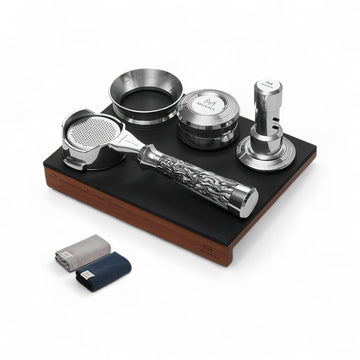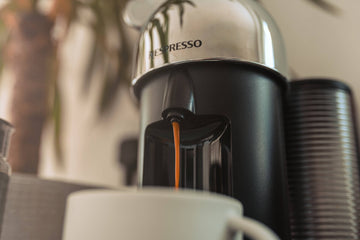No matter what brand of Espresso machines you have purchased, you often face popular problems. Unluckily, these issues are likely to restrict many of us from experiencing coffee shots at the start of a new day and other times. Water in an Espresso pod holder is a common example that you encounter to solve.
Water in the Espresso pod holder
Your Espresso pod holder contains water, meaning that the machine is leaking. Water in the pod holder can damage the whole machine or the pods. If water goes to the Espresso pod holder, the pods become soggy and impact the quality of your Espresso cups (of course).
Water is a perfect element to raise mold and bacteria surrounding the tank. When you identify the water that gets into the pod holder, you should dry it immediately before using it. Moreover, you need to clean and maintain your device on a regular basis to prevent water leakage.
Prominent problems in the Espresso coffee maker
Are you having problems making your cups of coffee? It will not be a matter when you realize common issues.
No heating and no steam
Lacking heating and steam is a popular and classic example of how something so easy could be destructive. Have you attempted turning the machine ON and OFF? Most companies provide power switches that might be set in more than one position.
This could be implied by 2 different buttons or a switch with different positions. On a machine of the Wea or Astoria, you will see 3 positions of 0, 1, and 2. The La Cimbali or Rancilio gives you 2 different switches.
In general, the first button (or position 1) will turn on all functions in the device, excluding the heating circuit. It is used by technicians when inspecting issues and maintaining the unit.
The second button (or position 2) will stimulate the heating circuit in the machine and allow the device to heat. Many of us usually cannot realize the ON/OFF switch and its different functions.
The button could surely be changed depending on the location.
- Someone cleans the steam arm and they may flick the switch on the back panel of the device.
- Someone who cleans the drip tray might suddenly touch the switch under the machine
No dispensing
You should remove the handle (from the group head) and reach a volumetric key. If the water runs OK, the coffee grind has been put too fine or you pack the handle with too much coffee.
Alter the coffee grind coarser and improve the dose into the basket. Nevertheless, if you push a volumetric key and the water displays signs of irregular running or a drizzle, this will be an instance that a technician is willing to help you resolve the problem.
Coffee leaking
If the Espresso machine is leaking from the back or the bottom, then the likely felon is a blocked drain hose or blocked internal pipe. The first way of realizing the cause of a leak is by observing the water that is leaking out.
If the water is still murky, then it could be the drain hose leakage. You need to remove the drain hose from the unit and get rid of blockages. If you find any visible rupture in the drain hose, then it will be a sign of replacement.
If the water is not murky, then the water leakage will appear in the internal pipes. This is not easy to repair and you will need to find a technician to solve the trouble. Please note that opening up the device and dabbling the pipes might abandon any warranty that you have on the machine.
If your Espresso maker is leaking frequently, then you should buy a new one rather than repair it regularly.
Coffee flows to the machine slowly
Coffee dispenses out to the machine at a snail’s pace. This is one of the most popular problems that you might find in your machine. It could be lacking pressure, meaning that the coffee does not have the thick texture and crema.
A single Espresso cup could take about 30 seconds to pull and the coffee probably goes out of the unit in a remaining stream. If it does not happen and the liquid coffee gets out of the machine slower than it, then it can be one of two problems.
- The dispersion display might be blocked
- The coffee grounds (in the portafilter basket) are too fine
If the coffee making time is longer than 30 seconds, then you will recognize that finely ground coffee is the culprit. Change the settings on the Espresso grinder to repair this. If the brewing time takes longer than 45 seconds (for a single shot), then the group head or dispersion display might be blocked with coffee residue.
Coffee leakage over the rim of portafilter
If coffee leaks outside of the portafilter, spreading badly extracted coffee grounds into the cup and drip tray, then the cause is the group head gaskets are worn. On most Espresso makers, to take the group seal out, you should unscrew the dispersion display from the group head.
When it is discharged, you need to pull off the gasket from the surrounding group head. To do it, you use a group seal pick to reach between the seal and the group head. A flathead screwdriver will work here with ease. When you have replaced the group seal, insert the dispersion screen and pull a shot. In almost all situations, the problems will be clarified.
The machine will not turn on
A blown fuse is one of the most common problems. Most Espresso machines contain 2 fuses – a power fuse and a thermal one. If the unit might not turn on all the time, then it is likely to blow the former.
If you can turn the machine on (but it cannot heat the water), it could indicate that the latter has exploded. Two fuses of the Espresso machines are always located close to each other. Nevertheless, these might vary between brands. If you identify that an issue in your apparatus is induced by a fuse blown, you will need to read the manual to find its location.
Clogged filter basket
Excess coffee grounds and other residues are the main reasons that your coffee has a bitter and horrible taste. You need to clean the reusable filter as it probably clogs up with the coffee essential oil, triggering a bad brew.
Loud noise when turning on the pump
The loud noise in the Espresso maker could be discordant, especially in a quiet environment. This is a horrible burst of sound that might shake anyone nearby. Nonetheless, it is an ordinary part of the Espresso-making process.
It proves that the device builds up natural pressure to press the water through the coffee grounds. If the noise could be loud, it will be a sign that the device is working. Moreover, the water tank is possibly full or the coffee is too coarse.
Solutions
Are you getting stuck in your morning coffee cups? Do not be concerned about it as troubleshooting popular problems with the Espresso machines could be notably simple.
Check the power supply
There is nothing more averting than a bad coffee maker in the early morning. You are amazing to wait for your coffee cups, but the machine does not work. For this reason, you need to check the power supply first.
Ensure your coffee machine is truly plugged into the wall outlet. Check the cord and plug for any possible damage. By taking some steps, make sure that your coffee machine is on and it is ready to give you fantastic coffee cups.
Inspect the water reservoir
If you get difficulties with the coffee device, it is necessary to check the water reservoir to ensure that there are no leakage or blockage points. Blockages and leaks may prevent the water flow to the equipment, leading to malfunction or not work.
Whether you use a domestic or a commercial machine, the issue often occurs and induces problems. It is always vital to notice your machine and maintain the function. Inspect the water reservoir to make sure of unforeseen coffee brewing.
Use fresh coffee beans
The secret to an authentic Espresso coffee cup begins with using fresh beans and grounds. No matter how expensive or tremendous your coffee machine is, if you use stale beans, you will not receive the best flavor. Stale beans minimize the coffee aroma and flavor. It is vital to grind your coffee beans before brewing to guarantee maximum freshness and aroma.
Moreover, it will inherit a persistent extraction, making sure that each shot is as mouth-watering as the last. Please keep in mind that you need to purchase fresh and high-quality coffee beans with a great grinder.
Clean the filter
No one wants to take up to a weak and lukewarm cup of coffee. One reason for underwhelming brews is a terrible filter with clogging in the coffee machine. Whether you own a fancy unit, a filter is an essential of the machine to wake you up in the morning.
Routinely checking and wiping down the filters may ensure your device is generating outstanding consequences every time. Do not let a clogged filter affect your coffee experience. Spend a few minutes to induce and maintain the coffee machine in order to relish authentic Espresso cups.
Change the grind size for excellent extraction
Attain the most splendid extraction in coffee shots could be a daunting task. An important factor in the coffee-making process is the grind size of the coffee beans. Adjusting the grind size setting might make big differences and get the greatest results.
Bottom line
In spite of the hardness of the design, the troubleshooting that Espresso machines include derives from a handful of causes. With those solutions mentioned above, you will diagnose the problems and repair them all. Be confident recognizing that you now receive all of the information needed to help your coffee maker run evenly.













